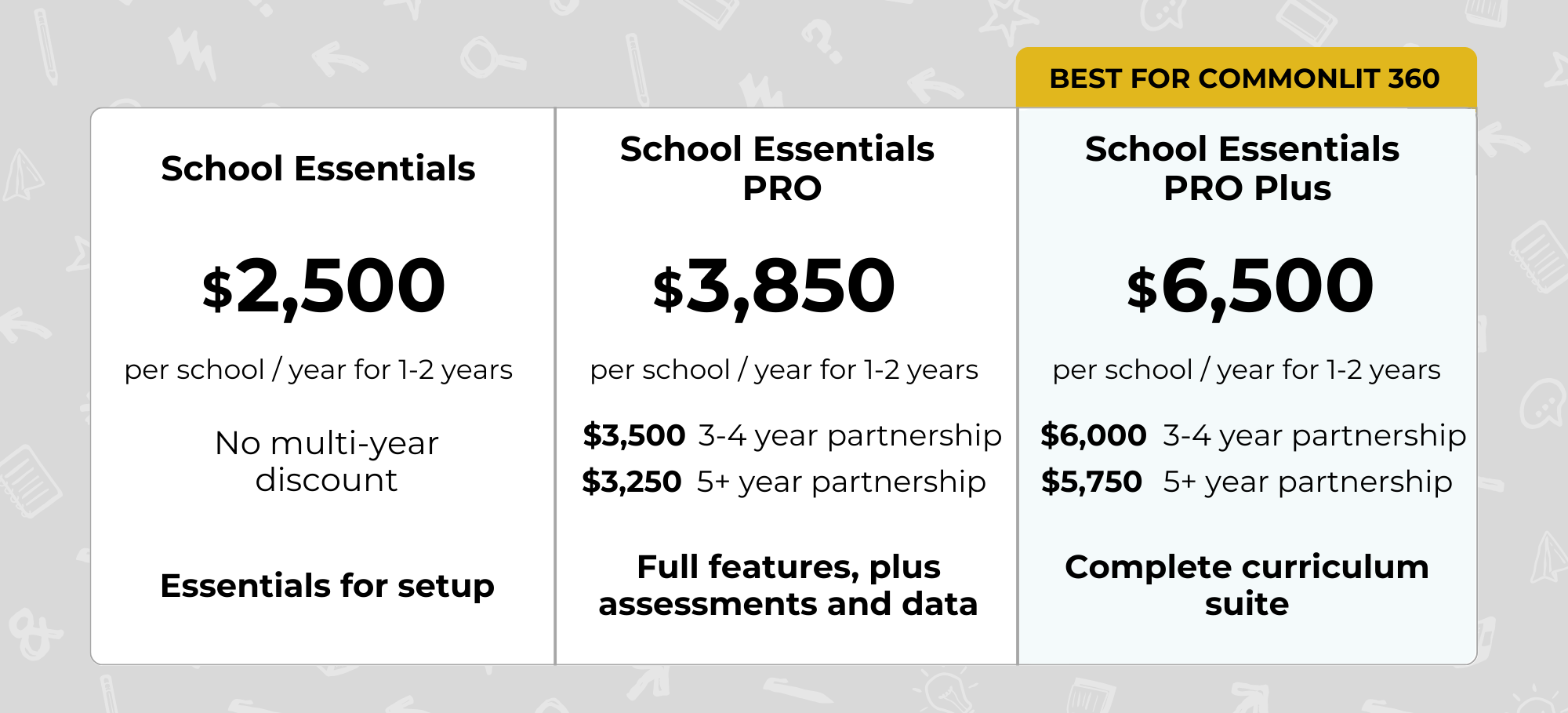Engage students with these incredible teaching strategies that will get them moving, talking, and learning!
CommonLit 360 is a rigorous and grade-level aligned curriculum that has been shown to help accelerate students’ learning. But, our team didn’t just design the curriculum to be grade-level aligned, we also designed it to be engaging and fun for students!
In this blog, we’ll highlight some of our favorite strategies for making CommonLit 360 come alive in your classroom!
Hook Students’ Interest
As English teachers, we know that one of our biggest jobs is to sell students on what we’re about to teach them. If we can prove that the next story is going to be exciting to read or that the next skill is critical to master, students will be eager to learn. The CommonLit 360 curriculum makes this easier for teachers with a couple of resources.
Unit Introduction Lessons
Each 360 Unit begins with a Unit Introduction lesson. These lessons are designed to spark student interest and discussion as they get the opportunity to preview the unit’s topic, big ideas, texts, and skill focus.
For example, as 10th graders begin the unit called “Coming of Age,” they’re asked several thought-provoking questions that relate directly to texts they’ll be reading later in the unit. These questions allow students to make text-to-self connections and will spark student discussion from the very beginning moments of the unit.
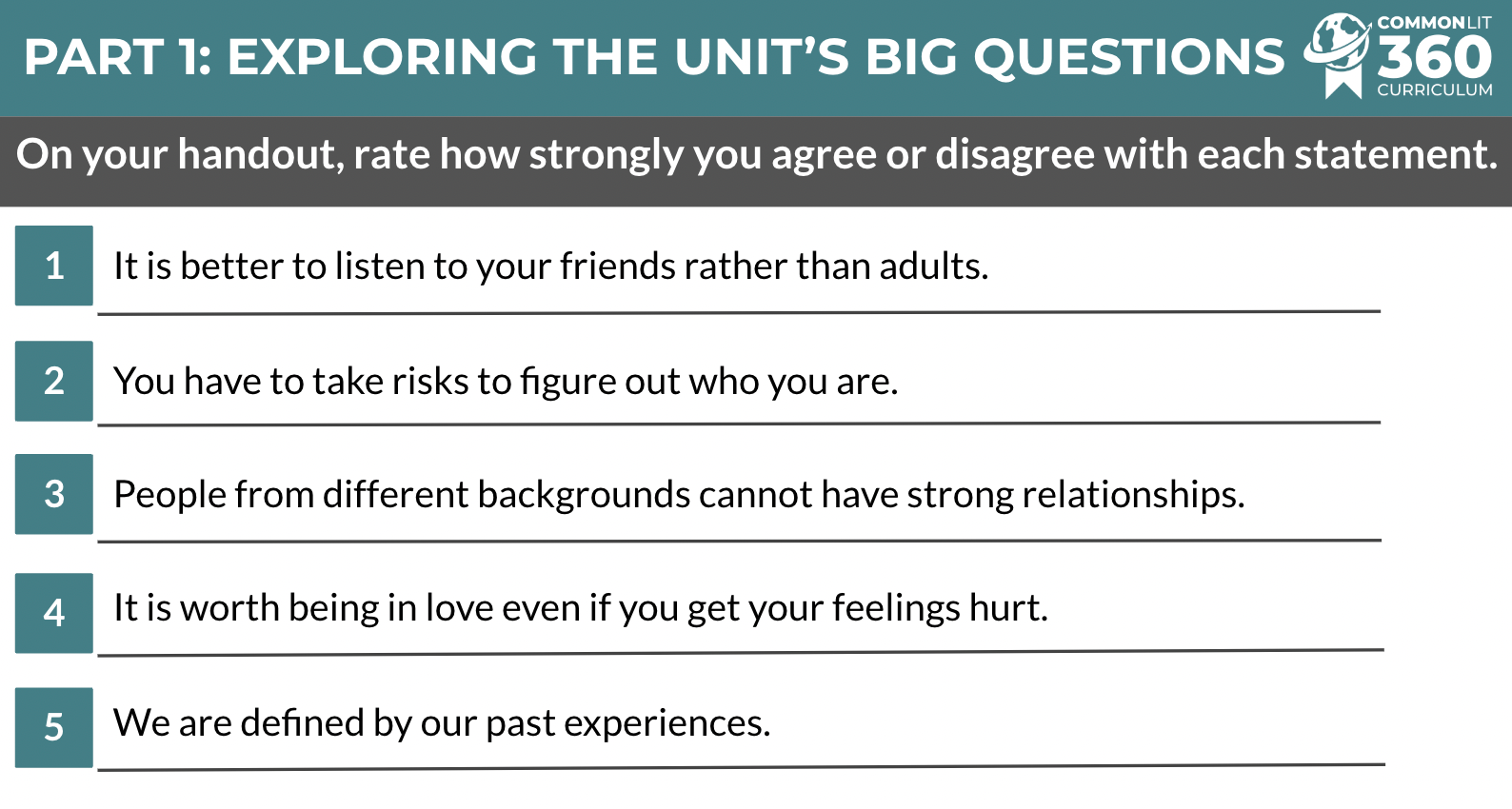
Reading Lesson Introductory Slide Decks
Each reading lesson in the 360 curriculum also includes an introductory slide show. These presentations will hook students’ interest and give them the key background knowledge they need to fully understand the text they’re about to read.
Before 10th graders begin reading “Safety of Numbers” by Lucy Tan, they’re given critical background information on China and the history of protests in the country. This information will be critical for students as they read the story.
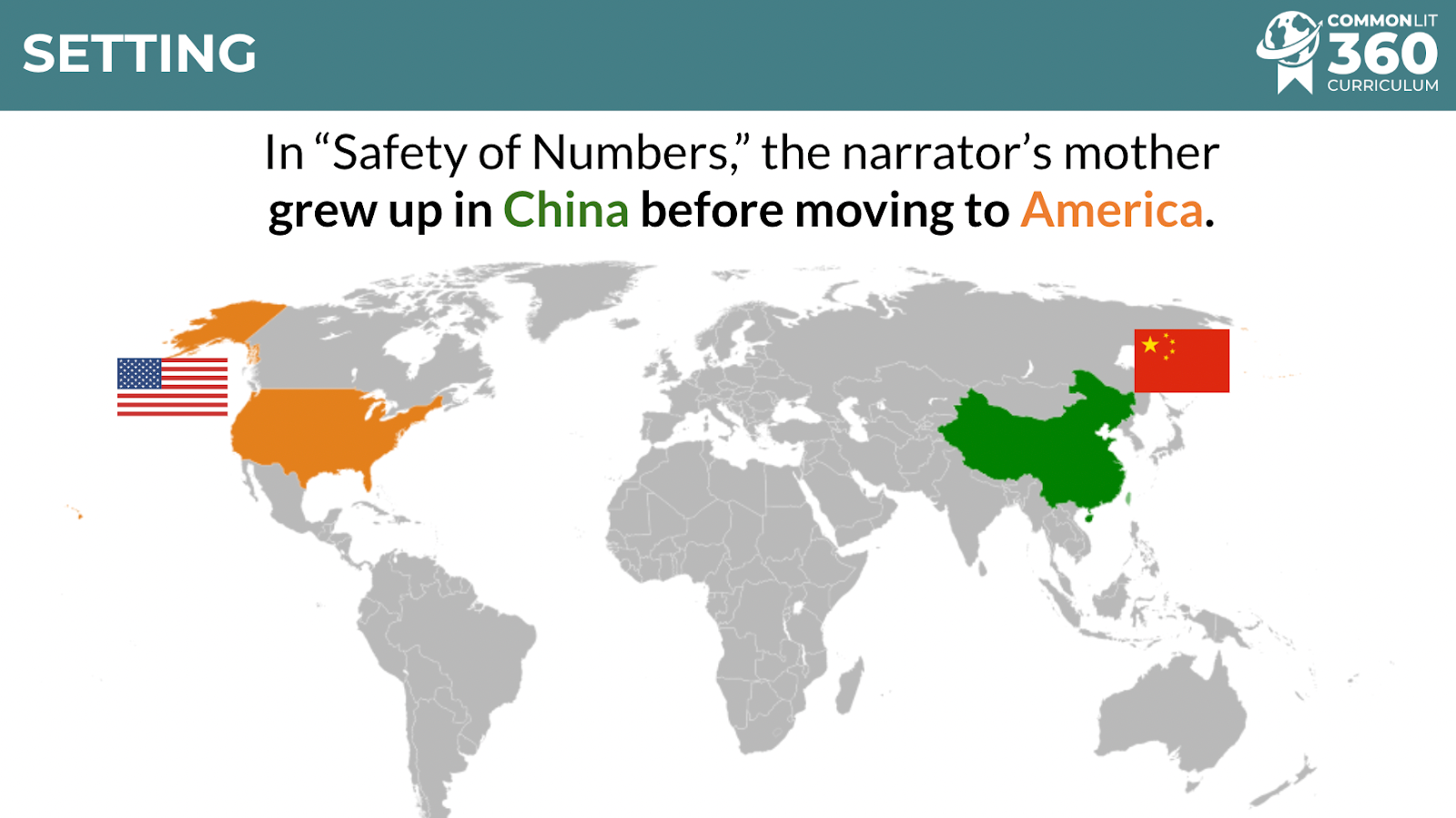

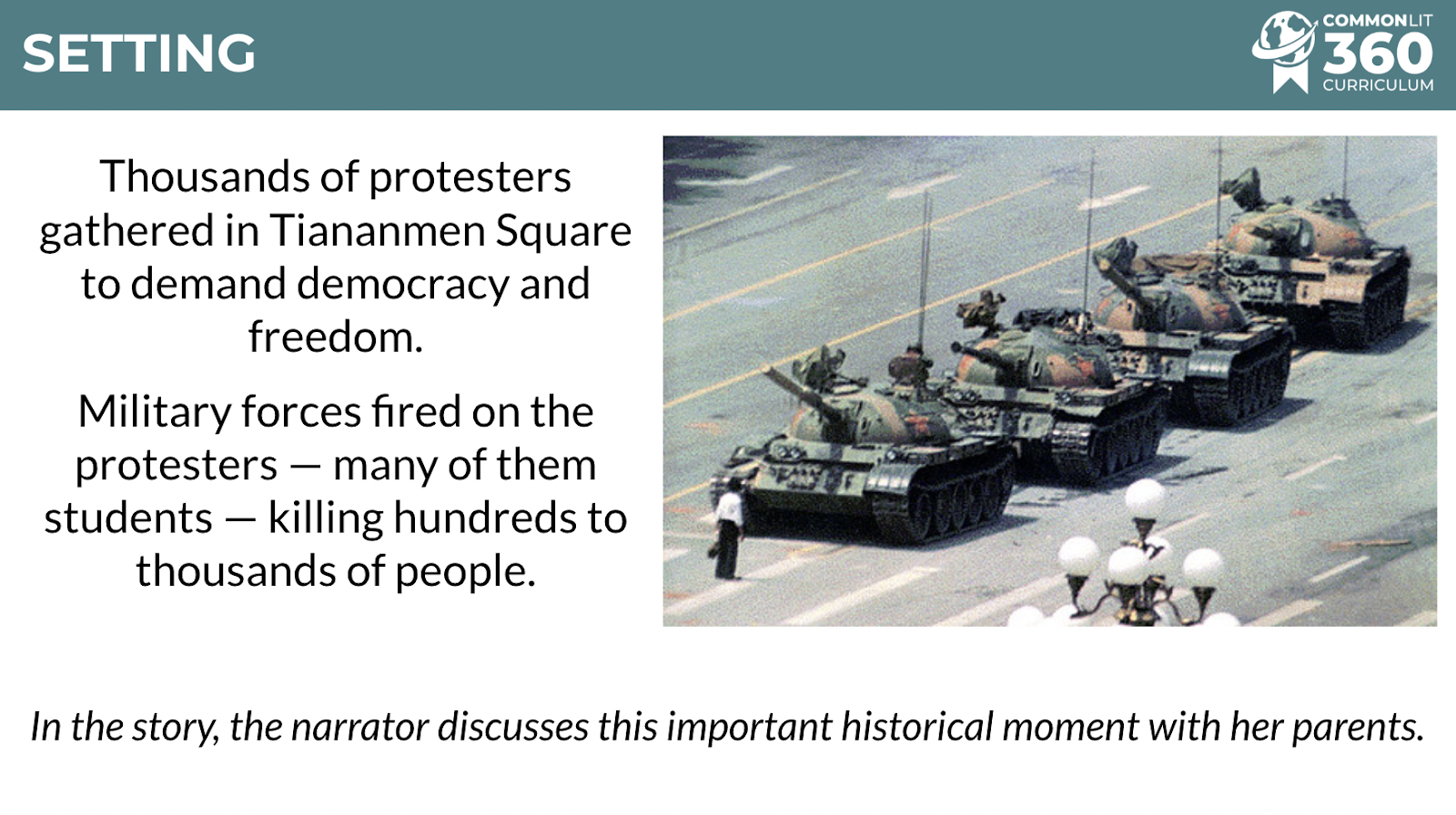
The unit introductory lesson and lesson introductions are all available as Google Slides and can be downloaded as PowerPoint presentations. So, teachers have the flexibility to modify or add additional resources to these presentations if they like!
Build Students’ Speaking, Listening, and Collaboration Skills
Related Media Explorations and discussion lessons included in the 360 curriculum are highly engaging and are a great way to build students’ discussion and collaboration skills. These lessons give students the opportunity to work closely with their peers, learn new concepts, and take ownership of their learning.
Related Media Explorations
As educators, we know that students’ reading comprehension is often boosted when they have greater knowledge of a topic (Alexander, Kulikowich, & Schulze, 1994). In the 360 curriculum, we strategically design Related Media Explorations that will give students the background knowledge they need to feel confident and engaged as they complete the unit’s reading lessons.
Let’s look at an example:
Right before 11th graders begin reading The Great Gatsby, students will complete an Exploration on the Roaring Twenties. As students watch educational videos, examine artifacts, and answer guiding questions, they’ll learn about the decadence, wealth disparity, and Prohibition that defined the era. This content knowledge will be critical when students begin reading the novel.
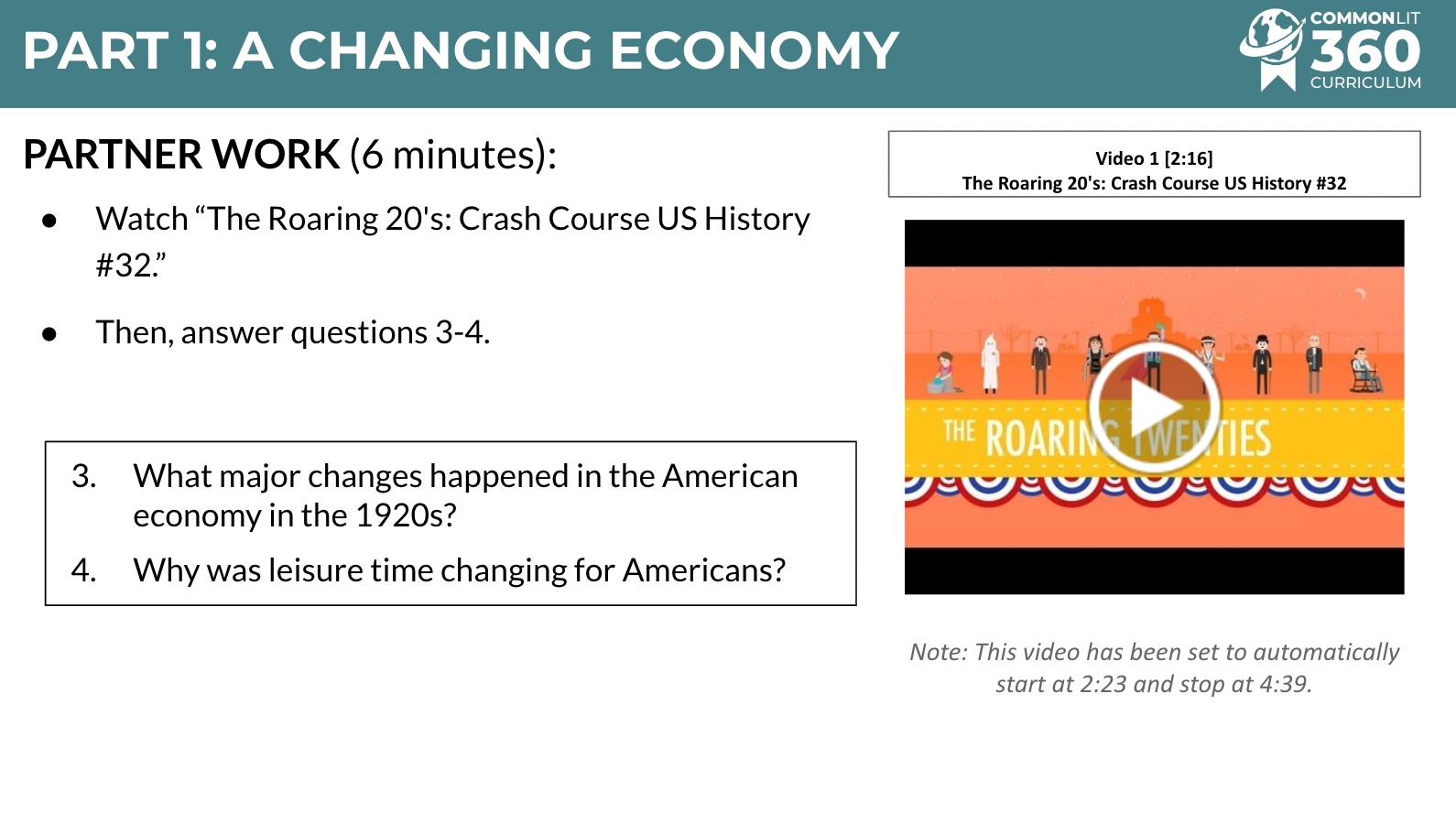
We recommend that teachers have students complete Related Media Explorations in partnerships or in small groups. These Explorations are a great opportunity to build students’ collaboration skills.
Discussion Lessons
Discussion lessons also play a critical role in the 360 curriculum. Discussion lessons are typically located towards the end of each unit and they give students an opportunity to reflect upon the texts they’ve read, the content they’ve learned, and the unit’s big ideas.
Let’s look at an example:
In 7th grade unit 4, after students have read several texts about the pros and cons of social media, they take part in a class discussion. To prepare for that discussion, they’re asked to reflect back on the texts they’ve read and synthesize their thoughts. During the class discussion, they answer thought-provoking questions like “should teens limit their own social media use?” and “what advice would you give to a younger teen who was first starting to use social media?”
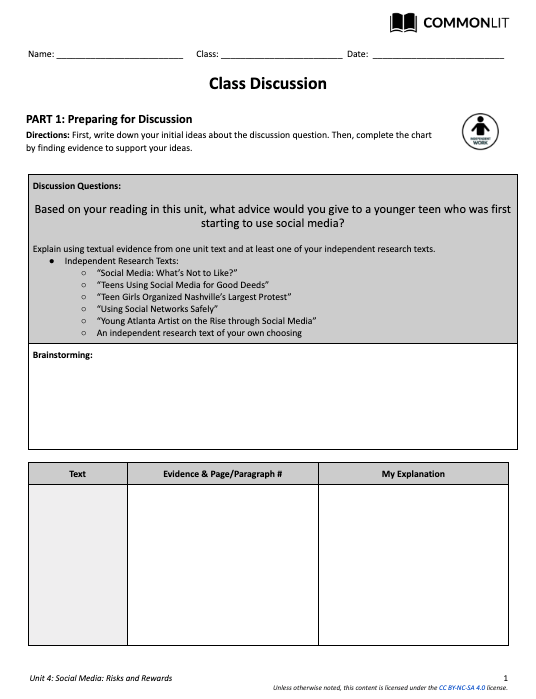
Class discussions are also a great opportunity for teachers to get creative and introduce some games or competition. Turn the discussion into a debate, add in additional discussion questions that you know will excite your students, or give students extra class points for thoughtful participation.
Incorporate Texts That’ll Spark Your Students’ Interest
Essential Reading Lessons serve as the backbone of each 360 unit. While we strongly recommend that teachers utilize each of those reading passages, teachers have lots of flexibility when choosing additional texts to use. CommonLit provides several resources but we also encourage teachers to be creative.
Supplemental Texts
360 Units often come with a handful of supplemental texts that teachers can draw from. These texts match up to the theme of the unit and span a variety of genres and difficulty levels. Teachers can choose the texts that they think will be most appealing to their students.
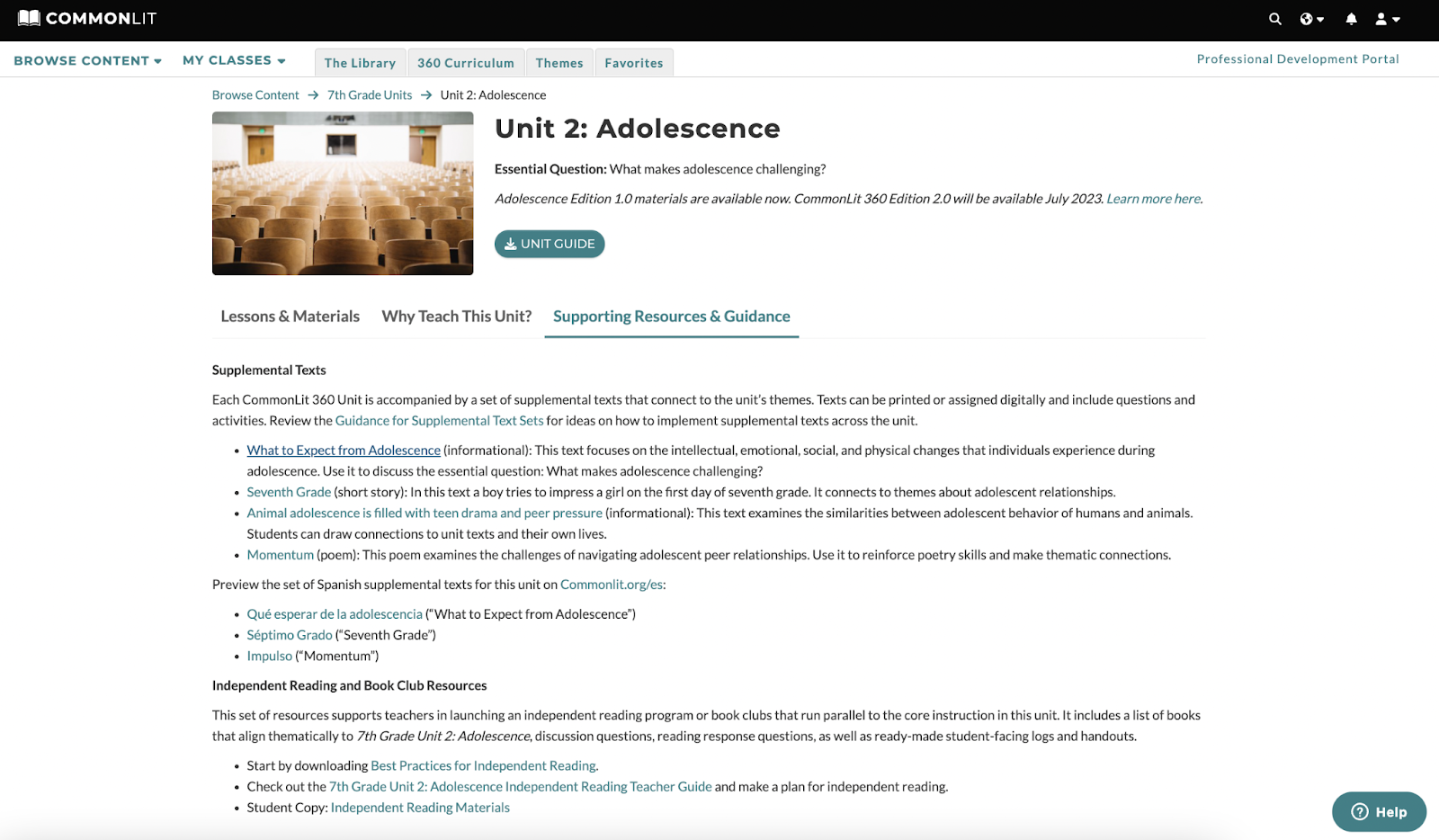
Independent Reading and Book Club Resources
Teachers can also access a list of books that connect to the theme or topic of each 360 unit. These book lists are a great resource for teachers who are looking to support struggling readers via guided reading. They can also be a wonderful way to push advanced learners who are eager for additional challenges. CommonLit also offers a variety of resources and planning materials to support independent reading and book clubs.
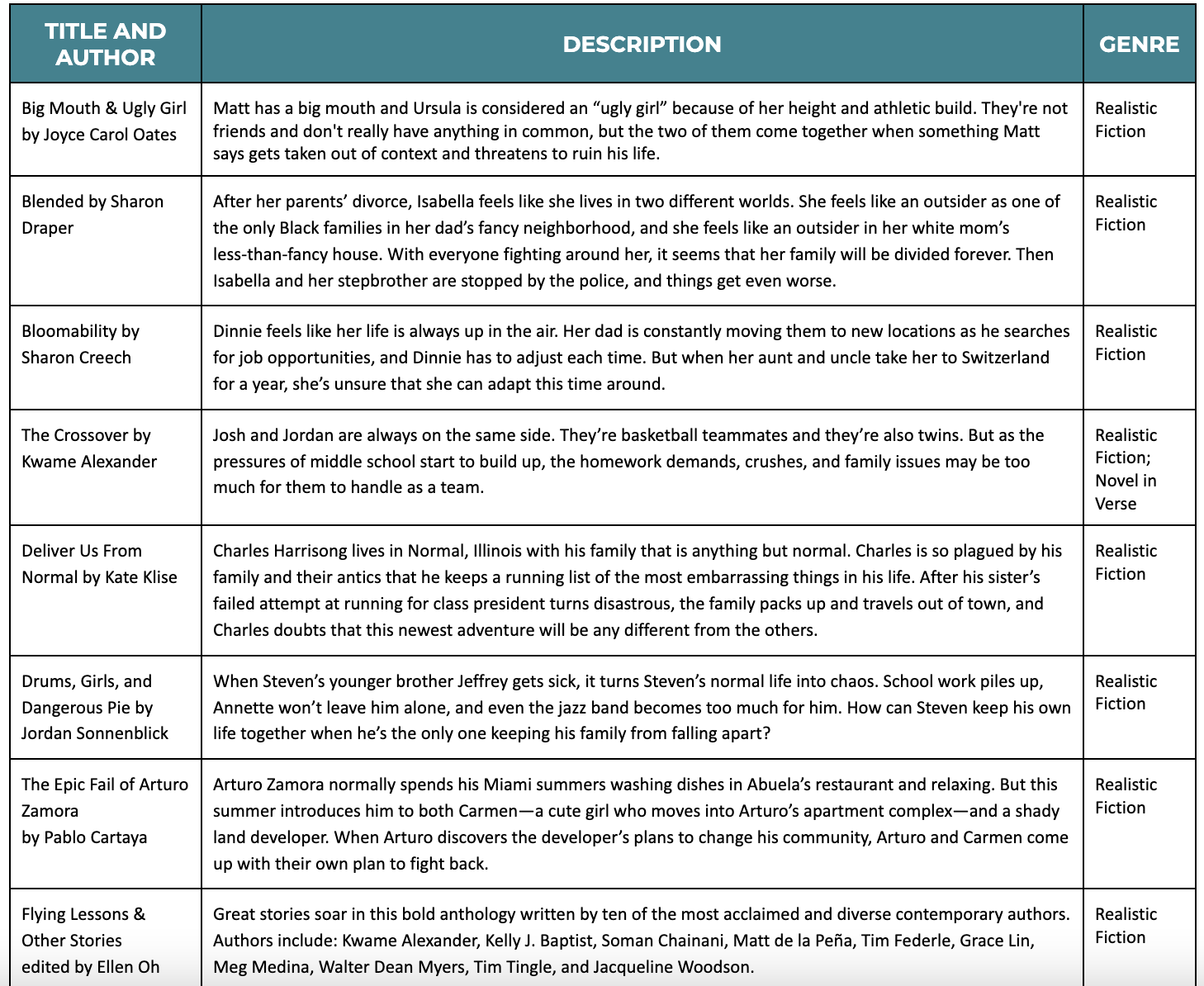
Teacher-Curated Resources
We also encourage teachers to identify additional resources that they think will appeal to their students. CommonLit offers thousands of lessons in its library and hundreds of Target Lessons that can be easily accessed. Teachers can also feel free to draw upon current events or other texts that they know will support and engage their students.
Maximize In-Class Time
Class time can feel short and it’s often challenging to get everything accomplished. While there are many 360 lessons that should be completed in class, there are some lessons that teachers can assign for homework or flex time.
Vocabulary Activities
Vocabulary instruction is a key part of the 360 curriculum. In each 360 unit, students complete 5 activities and learn roughly 10 grade-level words that will help them in ELA class and beyond.
Each vocabulary set begins with a prediction activity. Students look at the new vocabulary word, see how it’s used in a sentence, and look at an image that depicts the vocabulary word. Then students make a prediction about what the word means.
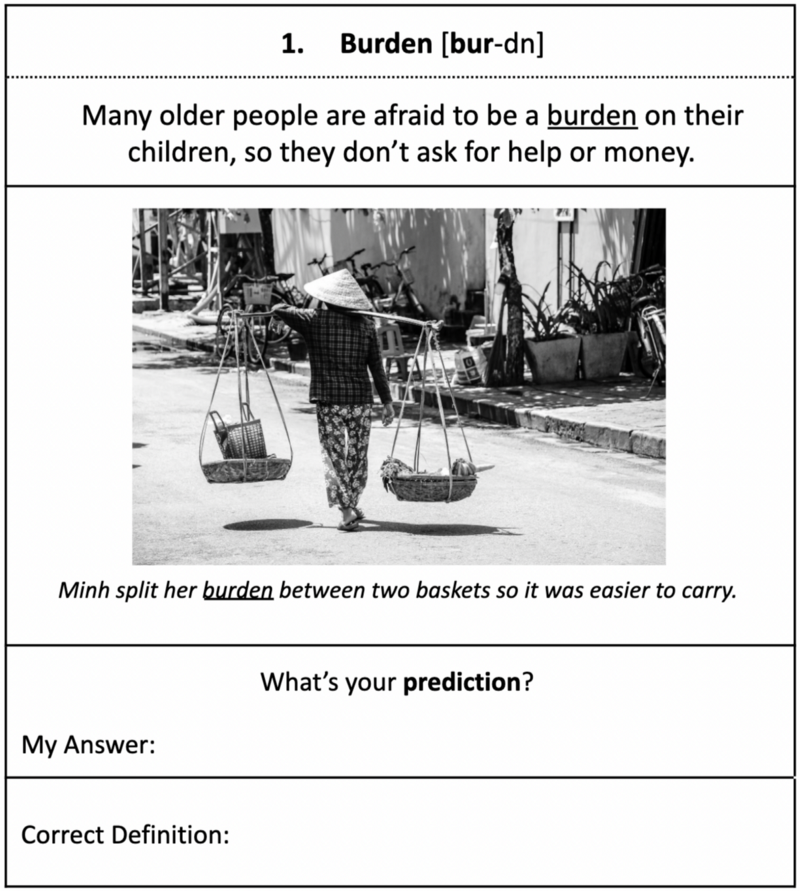
This is an engaging and important activity that we recommend teachers do with students.
However, teachers can be creative in how they assign the next four vocabulary activities. For example, teachers might choose to have students complete one activity per day as homework, as a Do Now, or during flex time.
After students complete these activities, teachers can spot check students’ work or have students review their answers with a partner.
At the end of the unit, students will complete a short digital quiz to see how many words they mastered.
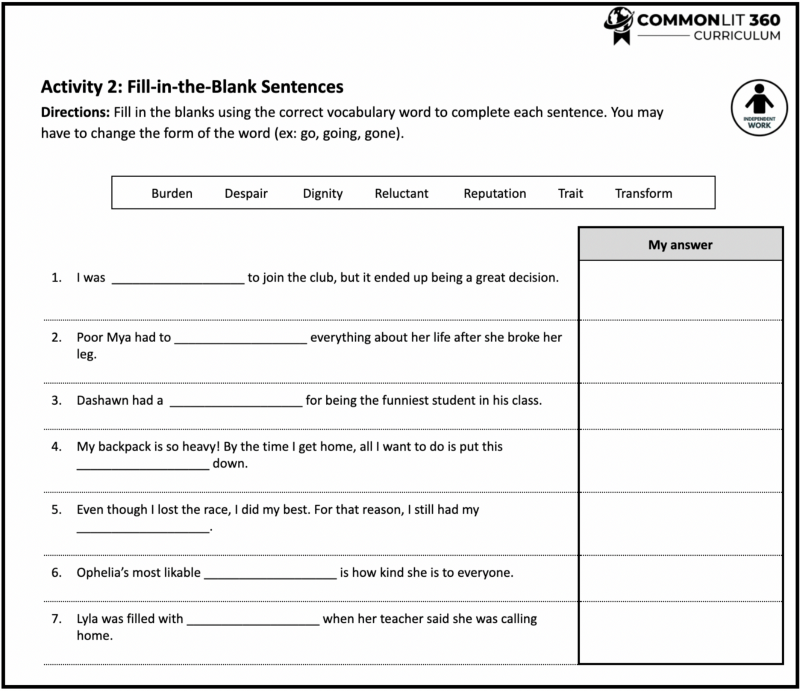
Grammar
Grammar instruction is optional within the 360 Curriculum and it follows a very similar structure to the vocabulary instruction. At the beginning of each grammar set, there is a short lesson that teachers will likely want to complete with students. After that initial lesson, teachers can have students flexibly complete the remaining activities.
Creative Writing Activities
Within the 360 curriculum, teachers will find writing lessons and assignments in each unit that are aligned to state standards and that will explicitly prepare students for what they will see on statewide assessments. Meanwhile, CommonLit’s team knows that it’s also critical to have writing assignments that will get students to think and write creatively.
Narrative Writing
In 7th grade unit “Adolescence,'' students read the hilarious short memoir “Going Steady” by Adam Bagdasarian. In the story, the narrator reflects back on how he awkwardly got into and out of his first relationship when he was in middle school.
After students complete that reading lesson, teachers have the option to assign students a narrative writing lesson where they rewrite the end of “Going Steady” from the perspective of Adam’s ex-girlfriend, Linda. This assignment will encourage students to think critically about Linda’s perspective, while giving them the freedom to write creatively.
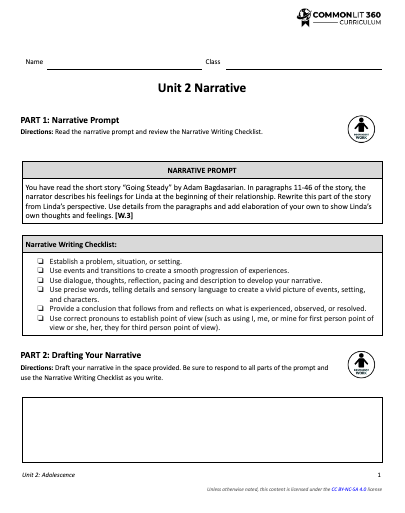
Alternative End-of-Unit Writing Options
In addition to the Culminating Task that is offered at the end of each 360 unit, CommonLit also offers several Alternative End-of-Unit Writing options. These alternative writing prompts give students the opportunity to write creatively.
For example, at the end of the 7th grade unit “Adolescence,” teachers may choose to have students:
- Write a personal reflection essay where they describe which character(s) from the unit they most relate to and why.
- Write an email to the author Adam Bagdasarian and explain what has remained the same and what has changed about being an adolescent today.
While these options are creative, students are still required to reflect carefully on the stories they’ve read and to cite evidence that supports their ideas.
Make Essential Reading Lesson Exciting
CommonLit wants reading to be fun! The more students enjoy reading, the more they’ll read, and the better readers they’ll become. That’s why we carefully choose texts that we think will hook students’ interest and encourage them to think critically.
Our CommonLit team also recommends a handful of instructional strategies to keep the reading lessons engaging and exciting.
Read Alouds
As teachers, we know one great way to hook students’ attention is to read portions of the story aloud to the class. As adults, we can model strong reading, do character voices, emphasize the most important words and more. For each 360 reading lesson, CommonLit recommends some whole-class reading. But, teachers should feel free to read additional portions of the text aloud to boost engagement.
Turn & Talks
Embedded within each Essential Reading Lesson are a handful of Turn & Talk questions. These questions are a great way to get students to work collaboratively and quickly answer a comprehension question with a partner. This is a great way to foster purposeful academic conversations!
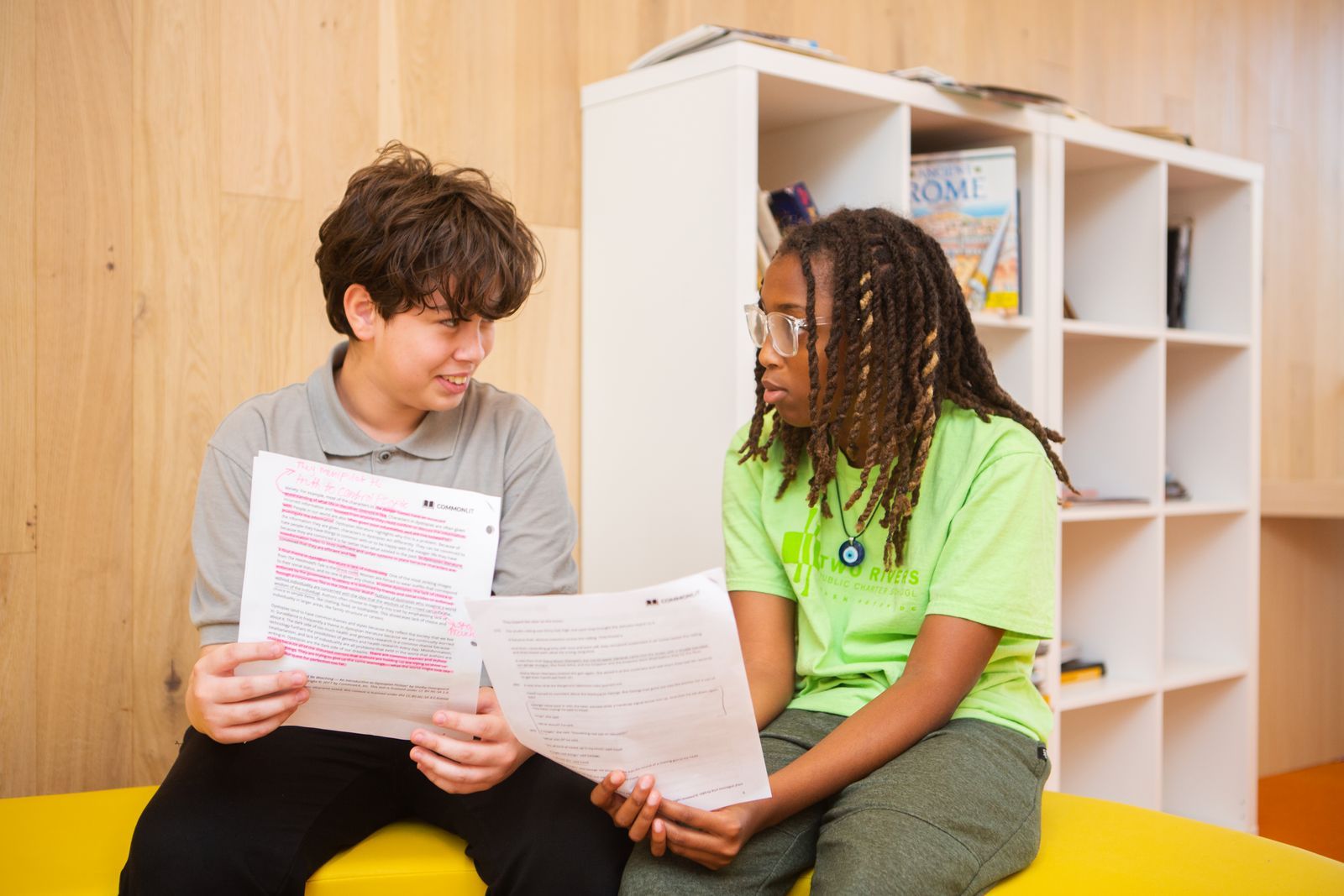
Partner Reading
Partner Reading gives students the chance to whisper read a portion of the text with a partner. Students will enjoy the opportunity to read and talk about the story with a partner.
Discussion Questions
At the end of each Essential Reading Lesson, teachers will find thought-provoking discussion questions. Teachers may choose to have students answer these questions as part of a whole class discussion, in small groups, or with a single partner. No matter what you choose, students will enjoy having the opportunity to express their opinions.
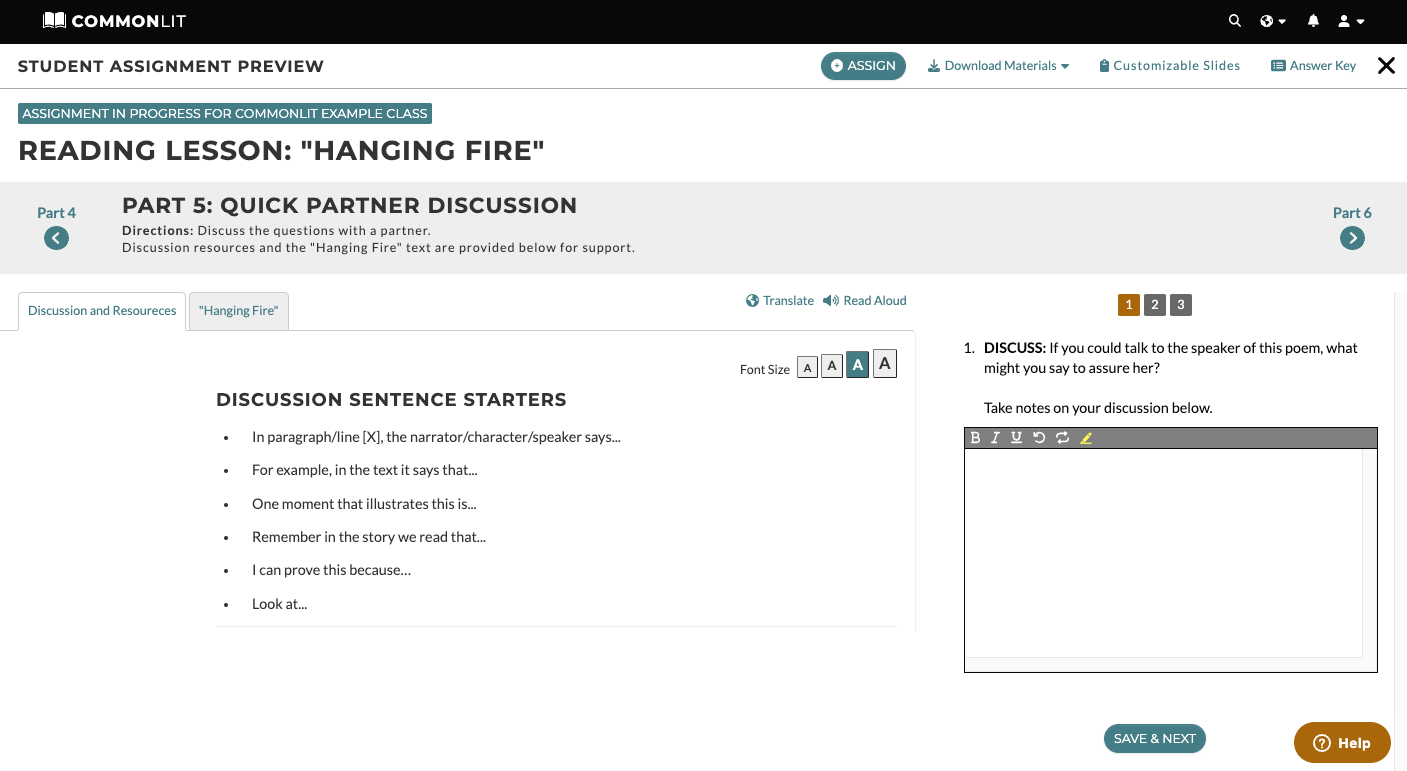
Utilize Strategies that Work for You!
CommonLit 360 comes with many lessons and resources that accelerate student learning and save teachers’ time. Meanwhile, we deeply value teachers’ creativity and the strategies that work with their students. So, please don’t hesitate to add in artistic activities, class debates, gallery walks, or any other instructional strategies that you know will get your students excited to learn.
Bring CommonLit 360 to Your School or District
Want to support usage of CommonLit 360 units in your school or district? Chat with our Partnerships team about our affordable paid features:
